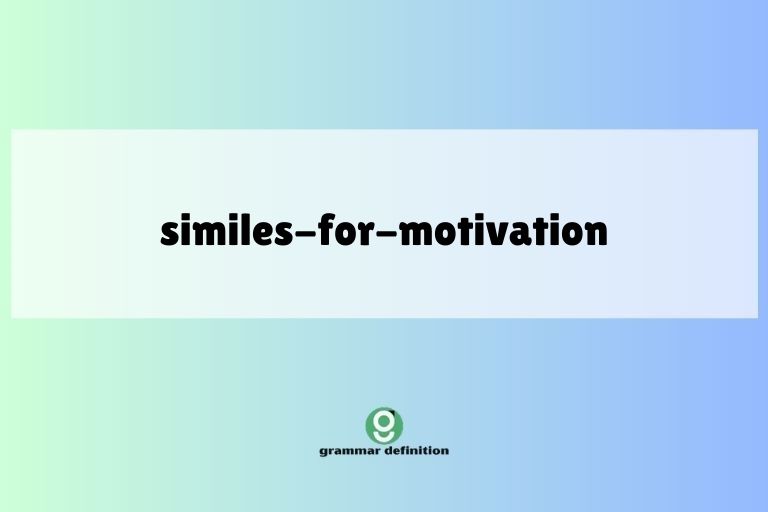Similes for Motivation: Ignite Your Inner Drive

Understanding and using similes effectively can add color and depth to your language, especially when it comes to motivation. Similes, by comparing one thing to another, can create powerful imagery and resonate deeply.
This article will explore the concept of similes, their structure, different types, and how they can be used to inspire and motivate yourself and others. Whether you are a student, a teacher, a writer, or simply someone looking to enhance your communication skills, this guide will provide you with the knowledge and tools to use similes for motivational purposes.
Table of Contents
- Introduction
- Definition of Simile
- Structural Breakdown of Similes
- Types of Similes
- Examples of Similes for Motivation
- Usage Rules for Similes
- Common Mistakes with Similes
- Practice Exercises
- Advanced Topics in Similes
- Frequently Asked Questions
- Conclusion
Definition of Simile
A simile is a figure of speech that directly compares two different things using the words “like” or “as.” The purpose of a simile is to create a vivid image or to emphasize a particular quality that the two things share. Similes are essential tools in both writing and speaking, adding depth, clarity, and emotional impact to communication.
They are frequently used in literature, poetry, and everyday conversation to make descriptions more engaging and memorable.
Unlike metaphors, which state that one thing *is* another, similes only suggest a resemblance. This distinction is crucial because it allows for a more nuanced and less absolute comparison.
The flexibility of similes makes them particularly useful in motivational contexts, where subtly influencing perception can be more effective than making declarative statements.
Structural Breakdown of Similes
The basic structure of a simile consists of three key components:
- The Subject: This is the thing being described or emphasized.
- The Comparison Word: This is typically “like” or “as,” which establishes the comparative relationship.
- The Object of Comparison: This is the thing to which the subject is being compared.
The formula can be represented as: Subject + Comparison Word + Object of Comparison.
For example, in the simile “He is as brave as a lion,” “He” is the subject, “as” is the comparison word, and “a lion” is the object of comparison. This structure allows for a clear and direct comparison, highlighting the subject’s bravery.
Understanding this structure is essential for creating effective similes. By carefully selecting the subject and the object of comparison, you can craft similes that are both accurate and impactful.
Types of Similes
Similes can be categorized based on their function and the type of comparison they make. Here are a few common types:
Descriptive Similes
These similes are used to describe a subject by comparing it to something else with a similar characteristic. For example, “The runner was as fast as the wind.”
Explanatory Similes
These similes are used to explain or clarify a concept by comparing it to something more familiar. For example, “Learning a new language is like climbing a mountain.”
Emphatic Similes
These similes are used to emphasize a particular quality or characteristic. For example, “She was as stubborn as a mule.”
Humorous Similes
These similes are used to create a humorous effect. For example, “He was as useful as a screen door on a submarine.”
Examples of Similes for Motivation
Similes can be powerful tools for motivation, inspiring action and fostering a positive mindset. Here are some examples categorized by the motivational theme they address:
Similes for Perseverance
These similes emphasize the importance of staying persistent and not giving up, even when faced with challenges. The following table provides examples of similes used to inspire perseverance.
| Simile | Explanation |
|---|---|
| Keep pushing forward; success is like a light at the end of a long tunnel. | Implies that success is attainable with continued effort. |
| Your determination should be like a river, constantly flowing despite obstacles. | Encourages relentless pursuit of goals. |
| Be as resilient as a rubber band; stretch and bounce back from setbacks. | Highlights the ability to recover from adversity. |
| Approach your goals like a marathon runner; pace yourself and stay the course. | Stresses the importance of endurance and strategic planning. |
| Your commitment should be like a rock, unyielding and steadfast. | Emphasizes the need for unwavering dedication. |
| Face challenges like a tree in a storm; bend but don’t break. | Promotes adaptability and resilience. |
| Work towards your dreams like a gardener tending to a plant; nurture it with care and patience. | Highlights the need for consistent effort and attention. |
| Your efforts should be like drops of water on a stone; over time, they will wear it down. | Emphasizes the power of consistent, small actions. |
| Be as persistent as a detective on a case; never give up until you find the solution. | Encourages relentless pursuit and problem-solving. |
| Confront obstacles like a mountain climber; one step at a time. | Stresses the importance of breaking down large tasks into manageable steps. |
| Your resolve should be like steel, strong and unbending. | Highlights the need for unwavering determination. |
| Keep striving, your potential is like a seed waiting to sprout. | Encourages growth and development. |
| Be as patient as a chess player, planning your moves carefully. | Promotes strategic thinking and long-term planning. |
| Your focus should be like a laser beam, concentrated and unwavering. | Emphasizes the importance of concentration. |
| Approach each day like a new chapter in a book; full of possibilities. | Encourages a fresh start and positive outlook. |
| Your spirit should be like a flame, burning brightly despite the darkness. | Highlights the importance of maintaining hope and enthusiasm. |
| Be as tenacious as a bulldog; never let go of your goals. | Emphasizes the need for unwavering determination. |
| Your progress may be slow, but it should be like a turtle; steady and consistent. | Encourages a focus on consistent effort, even if progress is gradual. |
| Your vision should be like a compass, guiding you towards your destination. | Highlights the importance of having a clear sense of direction. |
| Be as relentless as the tide, always pushing forward. | Encourages continuous effort and persistence. |
| Your ambition should be like a skyscraper, reaching for the sky. | Highlights the importance of striving high and aiming for greatness. |
| Be like a bamboo tree, resilient and flexible in the face of adversity. | Stresses the need for adaptability and strength in challenging times. |
| Your courage should be like a lion’s roar, bold and fearless. | Emphasizes the importance of bravery and confidence in pursuing goals. |
| Your passion should be like a fire, burning brightly and fueling your efforts. | Highlights the role of passion in driving motivation and success. |
Similes for Self-Belief
These similes aim to boost confidence and self-esteem, encouraging individuals to believe in their abilities and potential. The following table provides examples of similes used to foster self-belief.
| Simile | Explanation |
|---|---|
| Believe in yourself; your potential is like an untapped gold mine. | Implies that everyone has hidden talents and abilities. |
| Your confidence should be like a shield, protecting you from doubt and fear. | Emphasizes the importance of self-assurance. |
| See yourself like a masterpiece in progress; constantly evolving and improving. | Highlights the ongoing nature of personal growth. |
| Your capabilities are like a vast ocean; explore their depths. | Encourages individuals to discover their full potential. |
| Approach challenges like a seasoned warrior; confident and prepared. | Stresses the importance of preparation and self-assurance. |
| Your self-worth is like a diamond; precious and unbreakable. | Emphasizes the inherent value of each individual. |
| Believe in your dreams like a child believes in magic; with unwavering faith. | Highlights the power of optimism and imagination. |
| Your inner strength is like a fortress, capable of withstanding any attack. | Emphasizes the resilience and fortitude within each person. |
| See your potential like a blank canvas; ready to be filled with your creations. | Encourages creativity and self-expression. |
| Your mind is like a garden; cultivate positive thoughts and ideas. | Stresses the importance of mental well-being and positive thinking. |
| Your spirit is like an eagle, soaring above limitations. | Encourages individuals to overcome obstacles and achieve great heights. |
| Believe in your abilities like a seasoned performer trusts their instincts. | Highlights the importance of trusting one’s own judgment and skills. |
| Your voice is like a unique instrument; use it to express yourself. | Encourages self-expression and communication. |
| See your challenges like stepping stones; leading you to greater heights. | Promotes a positive perspective on difficulties. |
| Your heart is like a compass; guiding you towards your true north. | Emphasizes the importance of following one’s passions and values. |
| Believe in your journey like a sailor trusts the stars; with unwavering faith. | Highlights the importance of trusting the process and staying on course. |
| Your love for yourself should be like a warm embrace, comforting and supportive. | Emphasizes the importance of self-compassion and care. |
| See your life like a tapestry; woven with unique experiences and stories. | Encourages appreciation for individuality and personal history. |
| Your smile is like a ray of sunshine; brightening the world around you. | Highlights the positive impact of optimism and kindness. |
| Believe in your purpose like an artist trusts their vision; with unwavering conviction. | Emphasizes the importance of having a clear sense of purpose and direction. |
| Your curiosity should be like a child’s wonder, open and limitless. | Stresses the importance of maintaining a sense of curiosity and exploration. |
| Your mind is like a sponge, absorbing knowledge and experiences. | Highlights the capacity for learning and growth. |
| Your dreams are like stars, guiding you through the night. | Emphasizes the importance of having aspirations and goals. |
| Your potential is like a seed, waiting to blossom into something beautiful. | Encourages growth and development. |
Similes for Overcoming Fear
These similes provide encouragement to face fears and anxieties, promoting courage and resilience in challenging situations. The following table provides examples of similes used to inspire courage.
| Simile | Explanation |
|---|---|
| Face your fears like a lion tamer; with courage and control. | Implies that fear can be managed and overcome with bravery. |
| Your courage should be like a lighthouse, guiding you through stormy seas. | Emphasizes the importance of inner strength in difficult times. |
| Approach challenges like a tightrope walker; focused and balanced. | Highlights the need for concentration and stability under pressure. |
| Your resilience should be like a phoenix, rising from the ashes. | Emphasizes the ability to recover from setbacks and emerge stronger. |
| Face uncertainty like a seasoned explorer; with curiosity and a sense of adventure. | Encourages a positive and proactive approach to the unknown. |
| Your determination should be like a dam, holding back the flood of fear. | Emphasizes the importance of willpower in overcoming anxiety. |
| Face your anxieties like a surgeon performing a delicate operation; with precision and care. | Highlights the need for careful planning and execution in challenging situations. |
| Your resolve should be like a fortress, impenetrable to fear and doubt. | Emphasizes the importance of mental fortitude in overcoming obstacles. |
| Face adversity like a sailor navigating rough waters; with skill and determination. | Highlights the need for adaptability and perseverance in challenging circumstances. |
| Your spirit should be like a mountain, standing tall against the winds of adversity. | Emphasizes the importance of inner strength and resilience. |
| Face your inner demons like a warrior confronting their adversaries; with courage and strength. | Encourages self-confrontation and the overcoming of personal challenges. |
| Your bravery should be like a roaring fire, consuming all doubts and insecurities. | Emphasizes the power of courage in overcoming fear. |
| Approach your fears like a scientist conducting an experiment; with curiosity and a desire to learn. | Highlights the importance of approaching challenges with a problem-solving mindset. |
| Your determination should be like a river, carving its path through the mountains of fear. | Emphasizes the importance of relentless pursuit in overcoming obstacles. |
| Face your anxieties like an artist creating a masterpiece; with passion and dedication. | Highlights the need for creativity and commitment in overcoming challenges. |
| Your resilience should be like a tree, weathering the storms of life. | Emphasizes the ability to withstand and recover from adversity. |
| Face uncertainty like a pioneer exploring new frontiers; with courage and a sense of adventure. | Encourages a positive and proactive approach to the unknown. |
| Your inner strength should be like a shield, protecting you from the arrows of fear. | Emphasizes the importance of inner resilience in facing challenges. |
| Face your fears like a dancer embracing the rhythm; with grace and confidence. | Highlights the importance of fluidity and self-assurance in challenging situations. |
| Your determination should be like a rock, unyielding in the face of adversity. | Emphasizes the importance of unwavering resolve in overcoming obstacles. |
| Face your anxieties like a gardener tending to a garden; with patience and care. | Highlights the need for nurturing and attention in overcoming personal challenges. |
| Your resilience should be like a bridge, connecting you to a brighter future. | Emphasizes the ability to overcome obstacles and move forward. |
| Face uncertainty like an architect designing a building; with vision and creativity. | Highlights the importance of innovation and planning in challenging situations. |
| Your inner strength should be like a beacon, guiding you through the darkness of fear. | Emphasizes the importance of inner guidance and resilience in facing challenges. |
Usage Rules for Similes
While similes are relatively straightforward, there are some rules to keep in mind to ensure they are used effectively:
- Clarity: The comparison should be clear and easily understood. Avoid obscure or overly complex comparisons.
- Relevance: The object of comparison should share a relevant characteristic with the subject.
- Originality: While common similes can be effective, strive for originality to make your writing more engaging.
- Context: Ensure the simile is appropriate for the context and tone of your writing or speech.
For instance, instead of saying “He was as something as something else,” opt for clearer and more relevant comparisons. For example, “He was as quick as a cheetah” is more effective than “He was as quick as a house.”
Common Mistakes with Similes
Here are some common mistakes to avoid when using similes:
| Mistake | Correct Example | Incorrect Example |
|---|---|---|
| Using clichéd similes | He was as determined as a marathon runner. | He was as busy as a bee. |
| Making illogical comparisons | Her voice was as smooth as velvet. | Her voice was as smooth as a rock. |
| Mixing metaphors and similes | The project was like a ship sailing smoothly. | The project was a ship sailing smoothly like a bird. |
| Using overly complex comparisons | His mind was as sharp as a razor. | His mind was as sharp as a hyper-dimensional blade forged in the fires of Mount Doom. |
| Using similes that don’t fit the context | The atmosphere was as tense as a drum. | The atmosphere was as cheerful as a drum. |
Practice Exercises
Test your understanding of similes with these exercises:
Exercise 1: Identifying Similes
Identify the similes in the following sentences:
| Question | Your Answer | Correct Answer |
|---|---|---|
| 1. Her smile was as bright as the sun. | “as bright as the sun” | |
| 2. He ran like the wind. | “like the wind” | |
| 3. The news hit him like a ton of bricks. | “like a ton of bricks” | |
| 4. She is as gentle as a lamb. | “as gentle as a lamb” | |
| 5. The city was as quiet as a graveyard. | “as quiet as a graveyard” | |
| 6. His anger was like a raging fire. | “like a raging fire” | |
| 7. The solution was as clear as day. | “as clear as day” | |
| 8. The children slept like logs. | “like logs” | |
| 9. The task was as easy as pie. | “as easy as pie” | |
| 10. Life is like a box of chocolates. | “like a box of chocolates” |
Exercise 2: Completing Similes
Complete the following similes with an appropriate comparison:
| Question | Your Answer | Correct Answer (Example) |
|---|---|---|
| 1. He was as strong as __________. | an ox | |
| 2. She sings like __________. | an angel | |
| 3. The snow was as white as __________. | cotton | |
| 4. They fought like __________. | cats and dogs | |
| 5. The water was as cold as __________. | ice | |
| 6. The night was as dark as __________. | pitch | |
| 7. The baby slept like __________. | a rock | |
| 8. The car was as fast as __________. | lightning | |
| 9. The joke was as old as __________. | the hills | |
| 10. The coffee was as bitter as __________. | gall |
Exercise 3: Creating Similes
Create your own similes to describe the following:
| Question | Your Answer |
|---|---|
| 1. Describe a determined person. | |
| 2. Describe a peaceful place. | |
| 3. Describe a difficult task. | |
| 4. Describe a joyful moment. | |
| 5. Describe a frightening experience. | |
| 6. Describe a creative idea. | |
| 7. Describe a supportive friend. | |
| 8. Describe a challenging goal. | |
| 9. Describe a relaxing vacation. | |
| 10. Describe an inspiring leader. |
Advanced Topics in Similes
For advanced learners, consider exploring the following:
- Extended Similes: These are similes that are developed over several sentences or paragraphs, creating a more elaborate comparison.
- Subverted Similes: These are similes that intentionally break the rules or expectations of traditional similes for comedic or ironic effect.
- Cultural Similes: These are similes that rely on specific cultural references or knowledge to be fully understood.
By delving into these advanced topics, you can further refine your understanding and use of similes.
Frequently Asked Questions
- What is the difference between a simile and a metaphor?
A simile compares two things using “like” or “as,” while a metaphor states that one thing *is* another. Similes are more direct comparisons, while metaphors are more implicit.
- Can a simile be too obvious or clichéd?
Yes, using overused similes can make your writing seem unoriginal and uninspired. Strive for fresh and creative comparisons.
- How can I make my similes more effective?
Choose comparisons that are relevant, clear, and vivid. Consider the context and tone of your writing.
- Are similes only used in writing?
No, similes are used in both writing and speaking to add color and emphasis to communication.
- Can I use similes in formal writing?
Yes, but use them judiciously. Ensure they enhance your message without making it seem too informal or frivolous.
- How do I avoid making illogical comparisons in similes?
Ensure that the two things you are comparing share a relevant and logical characteristic.
- What role do similes play in motivational speaking?
Similes can make abstract concepts more relatable and understandable, helping to inspire and motivate audiences by creating vivid and memorable images.
- How can I practice using similes effectively?
Practice writing similes in different contexts, and ask for feedback from others. Pay attention to how similes are used in literature and everyday conversation.
Conclusion
Similes are a powerful tool for adding depth, clarity, and emotional impact to your language, particularly when it comes to motivation. By understanding their structure, types, and usage rules, you can effectively use similes to inspire action, foster self-belief, and encourage resilience.
Remember to strive for originality and relevance in your comparisons, and avoid common mistakes that can weaken their impact. With practice, you can master the art of using similes to ignite your inner drive and motivate others.
Continue to explore and experiment with similes in your writing and speaking. Pay attention to how effective speakers and writers use them to create memorable and impactful messages.
The more you practice, the more natural and effective your use of similes will become.






